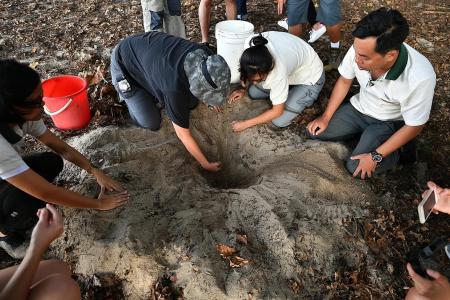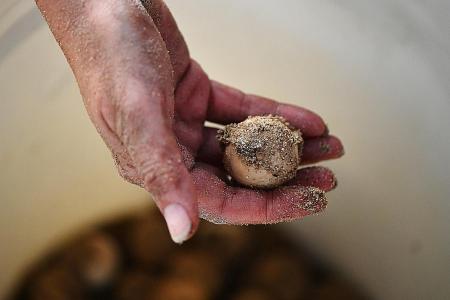Turtle eggs rescued from East Coast Park
They were then transported to the turtle hatchery at Sisters' Islands Marine Park
Staff and volunteers with the National Parks Board (NParks) took part in a mission to rescue 152 eggs laid by a hawksbill turtle - a critically endangered species - at the East Coast Park yesterday.
The rescuers took about an hour to painstakingly retrieve the eggs by hand, as they were afraid they could damage the eggs if they had used tools.
After the eggs were retrieved, they were carefully placed in a bucket filled with moist sand, to be transported to the turtle hatchery at Sisters' Islands Marine Park.
There, the eggs were reburied 42cm deep in sand - the same depth they were found at in East Coast Park.
The nest had been spotted about 50 days ago by a National University of Singapore student researcher, who then informed NParks.
After NParks verified the sighting as a nest, a decision was made to move the eggs as the site was deemed risky for the baby turtles, said Mr Collin Tong, senior manager for the coastal and marine branch of NParks' National Biodiversity Centre.
He said: "The nest site is next to a construction site, which is brightly lit at night."
Turtle hatchlings use environmental cues, including the moonlight, to make their way from sand to sea. Light from other sources could confuse the young turtles.
But there is no light pollution at the offshore Sisters' Islands, said Mr Tong.
The hope is that when the baby turtles emerge from the hatchery, the females would "imprint" on the beach - orienting themselves using the earth's magnetic field to return to Singapore's Southern Islands to nest when they become sexually mature in 25 years or so.
There are two species of sea turtles in Singapore: the hawksbill and green turtles.
These reptiles can be directly affected by climate change, as their sexes are influenced by temperatures. Female turtles hatch in warmer temperatures, whereas males hatch in cooler environments. In a warming world, this could skew the ratio of the sexes.
Mr Tong said NParks is able to control temperatures at the hatchery, maintaining sand temperatures at about 29 deg C, so it is more likely that a mix of male and female turtles would hatch from the clutch.
Hawksbill turtle nests have been spotted along Singapore's eastern coast, from Changi to the beaches along East Coast Park. But their nesting grounds may be under threat if land reclamation works take place along the eastern coast.
Naturalist Bernard Seah, 50, noted that East Coast Park is currently located on reclaimed land.
He said: "I have mixed thoughts about the possibility that East Coast might be reclaimed further. Singapore needs more land, but we're not sure about how it will affect the turtles.
"But if the development eventually goes ahead and is done in a careful way, such as if it is done in segments, turtles will still have room to nest. This way, a balance can be struck."
Get The New Paper on your phone with the free TNP app. Download from the Apple App Store or Google Play Store now




